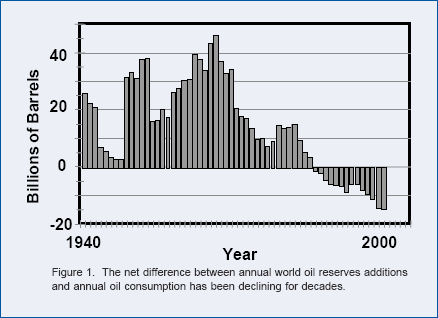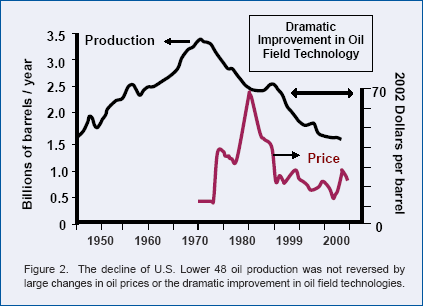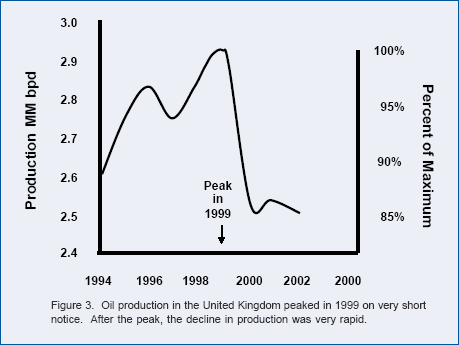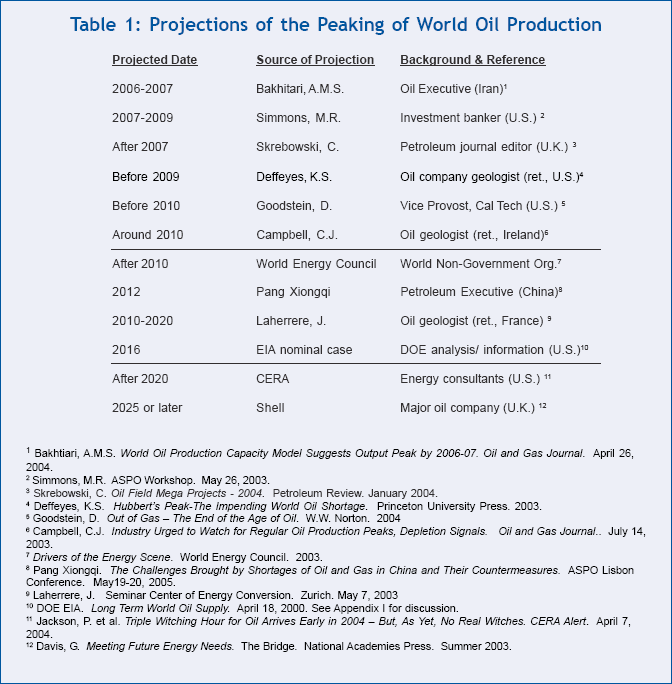|
TUESDAY EDITION December 23rd, 2025 |
|
Home :: Archives :: Contact |
 |
The Inevitable Peaking of World Oil Production Robert L. Hirsch October 22nd, 2005 Reprinted with permission from The Atlantic Council
Oil is the lifeblood of modern civilization. It fuels most transportation worldwide and is a feedstock for pharmaceuticals, agriculture, plastics and a myriad of other products used in everyday life. The earth has been generous in yielding copious quantities of oil to fuel world economic growth for over a century, but that period of plenty is changing. In the following, we describe the nature of the problem, options for mitigation, and required timing. The exact date of peaking is not known; some think it will be soon, others think a decade or more. However, the date is almost irrelevant as mitigation will take much longer than a decade to become effective, because of the enormous scale of world oil consumption. Background Oil was formed by geological processes millions of years ago and is typically found in underground reservoirs of dramatically different sizes, at varying depths, and with widely varying characteristics. The largest oil fields1 are called “super giants,” many of which were discovered in the Middle East. Because of their size and other characteristics, super giant oil fields are generally the easiest to find, the most economic to develop, and the longest-lived. The world’s last super giant oil fields were discovered in the 1960s. Since then, smaller fields of varying sizes have been found in what are called “oil prone” locations worldwide — oil is not found everywhere. The concept of the peaking of world oil production follows from the fact that the output of an individual oil field rises after discovery, reaches a peak, and then declines. Oil fields have lifetimes typically measured in decades, and peak production often occurs roughly a decade or so after discovery under normal circumstances. It is important to recognize that oil production peaking is not “running out.” Peaking is the maximum oil production rate, which typically occurs after roughly half of the recoverable oil in an oil field has been produced. What is likely to happen on a world scale will be similar to what happens with individual oil fields, because world production is by definition the sum total of production from all of the world’s oil fields. Oil is usually found thousands of feet below the surface. Most oil fields do not have an obvious surface signature, so oil is very difficult to find. Advanced technology has greatly improved the discovery process and reduced exploration failures. Nevertheless, world oil discoveries have been steadily declining for decades, as shown below. Oil Reserves Oil reserves are in some ways like inventory in a business, but the analogy can be deceiving. “Reserves” is an estimate of the amount of oil in an oil field that can be extracted at an assumed cost. Thus, a higher oil price outlook often means that more oil can be produced. However, geological realities place an upper limit on price-dependent reserves growth. Reserves estimates are revised periodically as an oil field is developed and new information provides a basis for refinement. Reserves estimation is a matter of gauging how much extractable oil resides in deep, obscure, complex rock formations, using inherently limited information. Reserves estimation is a bit like a blindfolded person trying to judge what the whole elephant looks like from touching it in just a few places. It is a far cry from counting cars in a parking lot, where all the cars are in full view. Specialists who estimate reserves use an array of technical methodologies and a great deal of judgment. Thus, different estimators might calculate different reserves from the same data. Sometimes self-interest influences reserves estimates, e.g., an oil field owner may provide a high estimate in order to attract outside investment, influence customers, or further a political agenda. Reserves and production should not be confused. Reserves estimates are but one factor used in estimating future oil production from a given oil field. Other factors include production history, local geology, available technology, oil prices, etc. An oil field can have large estimated reserves, but if a well-managed field has past maximum production, the remaining reserves can only be produced at a diminishing rate. Sometimes decline can be slowed, but a return to peak production is impossible. This fundamental is not often appreciated by those unfamiliar with oil production. Production Peaking World oil demand is forecast to grow 50 percent by 2025.2 To meet that demand, ever-larger volumes of oil will have to be produced. Since oil production from individual oil fields grows to a peak and then declines, new fields must be continually discovered and brought into production to compensate for the depletion of older fields and to meet increasing world demand. If large quantities of new oil are not discovered and brought into production somewhere in the world, then world oil production will no longer satisfy demand. Peaking means that the rate of world oil production cannot increase; it does not mean that production will suddenly stop, because there will still be large reserves remaining. The peaking of world oil production has been a matter of speculation from the beginning of the modern oil era in the mid 1800s. Initially, little was known about petroleum geology, so predictions of peaking were no more than rank speculation. Over time, geological understanding improved dramatically and guessing gave way to more informed projections, although the knowledge base involves numerous uncertainties, even today. As indicated in Table I (see page 9), some forecasters believe that world oil production peaking might occur very soon. Others argue that we may have more than a decade of plentiful oil, which is the position of Daniel Yergin of Cambridge Energy Research Associates, as recently expressed in an op-ed piece in the Washington Post.3 Until recently, OPEC assured the world that oil supply would continue to be plentiful, but that position is changing. Some in OPEC are now warning that oil supply will not be adequate to satisfy world demand in 10-15 years.4 Such declarations are in line with the widely discussed questions about Saudi Arabian oil reserves raised by Matthew Simmons in his recent book.5 Even Dr. Sadad al-Husseini, a retired senior Saudi Aramco oil exploration executive, is on record as saying that the world is heading for an oil shortage; in his words “a whole new Saudi Arabia [will have to be found and developed] every couple of years’’ to satisfy current demand forecasts.6 So the messages from the world’s “breadbasket of oil” are moving from confident assurances to warnings of approaching shortage. Types of Oil Oil is classified as “Conventional” and “Unconventional.” Conventional oil is typically the highest quality, lightest oil, which flows from underground reservoirs with comparative ease, and it is the least expensive to produce. Unconventional oils are heavy, often tar-like and are not readily recovered because production often requires a great deal of capital investment and supplemental energy. For that reason, most current world oil production is conventional oil.7 The Oil Price-Reserves Nexus In the past, higher prices led to increased estimates of conventional oil reserves worldwide. However, this price-reserves relationship has its limits, because oil is found in discrete packages (reservoirs) as opposed to the varying concentrations characteristic of many minerals. Thus, at some price, world reserves of recoverable conventional oil will reach a maximum because of geological fundamentals. Beyond that point, insignificant additional conventional oil will be recoverable at any realistic price. This is a geological fact that is often not understood by economists, many of whom are accustomed to dealing with hard minerals, whose geology is fundamentally different.
 Oil companies and governments have conducted extensive exploration worldwide, but their results have been disappointing for decades. On this basis, there is little reason to expect that future oil discoveries will dramatically increase. The situation is illustrated in Figure 1, which shows the difference between annual world oil reserves additions and annual consumption.8 The image is one of a world moving from a long period in which reserves additions were much greater than consumption, to an era in which annual additions are falling increasingly short of annual consumption. A related fact is that oil production is in decline in 33 of the world’s 48 largest oil-producing countries.9 Impacts of Improved Technology and Higher Prices Exploration for and production of petroleum has been an increasingly more technological enterprise, benefiting from more sophisticated engineering capabilities, advanced geological understanding, improved instrumentation, greatly expanded computing power, more durable materials, etc. Today’s technology allows oil fields to be more readily discovered and better understood sooner than heretofore.
 Some economists expect improved technologies and higher oil prices will provide ever-increasing oil production for the foreseeable future. To gain some insight into the effects of higher oil prices and improved technology on oil production, consider the history of the U.S. Lower 48 states. This region was one of the world’s richest, most geologically varied, and most productive up until 1970, when production peaked and started into decline. Figure 2 shows Lower 48 historical oil production with oil prices and technology trends superimposed. In constant dollars, oil prices increased by roughly a factor of three in 1973- 74 and another factor of two in 1979- 80. In addition to these huge oil price increases, the 1980s and 1990s were a golden age of oil field technology development, including practical 3-D seismic, economic horizontal drilling, dramatically improved geological understanding, etc. Nevertheless, as Figure 2 shows, Lower 48 oil production still trended downward, showing no pronounced response to either price or technology. In light of this experience, there is no reason to expect that the worldwide situation will be different: Higher prices and improved technology are unlikely to yield dramatically higher conventional oil production. Peaking of World Oil Production Various individuals and groups have used available information and geological tools to develop forecasts for when world oil production might peak. A sampling is shown in Table 1, where it is clear that many believe that peaking is likely within a decade. Mitigation A recent analysis for the U.S. Department of Energy addressed the question of what might be done to mitigate the peaking of world oil production.10 Various technologies that are commercial or near commercial were considered:
A scenario analysis was performed, based on crash program implementation worldwide – the fastest humanly possible. Three starting dates were considered:
The timing of oil peaking was left open because of the considerable differences of opinion among experts. Consideration of a number of implementation scenarios provided some fundamental insights, as follows:
The reason why such long lead times are required is that the worldwide scale of oil consumption is enormous – a fact often lost in a world where oil abundance has been taken for granted for so long. If mitigation is too little, too late, world supply/demand balance will have to be achieved through massive demand destruction (shortages), which would translate to extreme economic hardship. On the other hand, with timely mitigation, economic damage can be minimized. Warning Signs In an effort to gain some insight into the possible character of world oil production peaking, a number of regions and countries that have already past oil peaking were recently analyzed.11 Areas that had significant peak oil production and that were not encumbered by major political upheaval or cartel action were Texas, North America, the United Kingdom, and Norway. Three other countries that are also past peak production, but whose maximum production was smaller, were Argentina, Colombia, and Egypt.
 Examination of these actual histories showed that in all cases it was not obvious that production was about to peak a year ahead of the event, i.e., production trends prior to peaking did not provide longrange warning. In most cases the peaks were sharp, not gently varying or flat topped, as some forecasters hope. Finally, in some cases post-peak production declines were quite rapid, as in the U.K. for example (Figure 3) It is by no means obvious how world oil peaking will occur, but if it follows the patterns displayed by these regions and countries, the world will have less than a year’s warning. It’s Not Your Mother’s Energy Crisis Oil peaking represents a liquid fuels problem, not an “energy crisis” in the sense that term has often been used. Motor vehicles, aircraft, trains, and ships simply have no ready alternative to liquid fuels, certainly not for the existing capital stock, which have very long lifetimes. Non-hydrocarbonbased energy sources, such as renewables and nuclear power, produce electricity, not liquid fuels, so their widespread use in transportation is at best many decades in the future. Accordingly, mitigation of declining world conventional oil production must be narrowly focused in the near-term. Risk Management It is possible that peaking may not occur for a decade or more, but it is also possible that peaking may be occurring right now. We will not know for certain until after the fact. The world is thus faced with a daunting risk management problem. On the one hand, if peaking is decades away, massive mitigation initiated soon would be premature. On the other hand, if peaking is imminent, failure to quickly initiate mitigation will impose large nearterm economic and social costs on the world. The two risks are asymmetric:
The world has never confronted a problem like this. Risk minimization requires the implementation of mitigation measures well prior to peaking. Since it is uncertain when peaking will occur, the challenge for decisionmakers is indeed vexing. Mustering support for an invisible disaster is much more difficult than for one that is obvious to all. Concluding Remarks Over the past century, world economic development has been fundamentally shaped by the availability of abundant, low-cost oil. Previous energy transitions (wood to coal, coal to oil, etc.) were gradual and evolutionary; oil peaking will be abrupt and revolutionary. The world has never faced a problem like this. Without massive mitigation at least a decade before the fact, the problem will be pervasive and long lasting. Oil peaking represents a liquid fuels problem, not an “energy crisis” in the sense that term has been used. Accordingly, mitigation of declining world oil production must be narrowly focused, at least in the near-term. A number of technologies are currently available for immediate implementation once there is the requisite determination to act. Governments worldwide will have to take the initiative on a timely basis, and it may already be too late to avoid considerable discomfort or worse. Countries that dawdle will suffer from lost opportunities, because in every crisis, there are always opportunities for those that act decisively.
 Acknowledgements The author deeply appreciates the encouragement and continuing support for the author’s work on peak oil by the management the U.S. Department of Energy’s National Energy Technology Laboratory. Roger Bezdek and Robert Wendling of Management Information Services, Inc. were major contributors to the analyses described herein. About The Author Robert L. Hirsch is a Senior Energy Program Advisor for SAIC. Previous employment included executive positions at the U.S. Atomic Energy Commission, the U.S. Energy Research and Development Administration, Exxon, ARCO, EPRI, and Advance Power Technologies, Inc. Dr. Hirsch is past chairman of the Board on Energy and Environmental Systems at the National Academies. He has a Ph.D. in engineering and physics from the University of Illinois. Reprinted from The Atlantic Council
|
| Home :: Archives :: Contact |
TUESDAY EDITION December 23rd, 2025 © 2025 321energy.com |
|